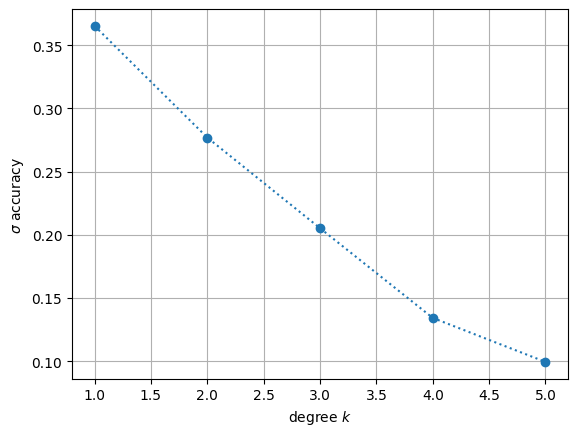# manually set mode to 64 bits (if desired)
from jax.config import config
config.update("jax_enable_x64", True)
# import the usual libraries
import jax
import jax.numpy as jnp
import numpy as np
import matplotlib.pyplot as plt
from functools import partial
from matplotlib.colors import LogNorm
import cyjax
# random number sequence
rns = cyjax.util.PRNGSequence(42)
No GPU/TPU found, falling back to CPU. (Set TF_CPP_MIN_LOG_LEVEL=0 and rerun for more info.)
Donaldson’s algorithm & volume#
As a first application, let us estimate the volume by MC integration. Optionally, an estimate for the variance can also be computed (based on the variance of the integrand).
dwork = cyjax.Dwork(3) # single parameter family
psi = jnp.array([10+3j]) # pick some moduli values
volcy, volcy_var = dwork.compute_vol(next(rns), psi, batch_size=500, var=True)
print('%.3f ± %.3f' % (volcy, jnp.sqrt(volcy_var)))
0.949 ± 0.001
volcy, volcy_var = dwork.compute_vol(next(rns), psi, batch_size=2000, var=True)
print('%.3f ± %.3f' % (volcy, jnp.sqrt(volcy_var)))
0.947 ± 0.001
Polynomial basis on variety#
For Donaldson’s algorithm, we need to choose a basis of the line bundle of chosen degree on the variety.
We cannot directly use the full set of monomials in ambient projective space since they are not independent on the variety (where any linear combination proportional to the defining polynomial vanishes).
A basic (but not necessarily numerically optimal) algorithm for a reduced basis is implemented.
Other methods can be added by creating a new subclass of cyjax.donaldson.LBSections.
degree = 5 # use homogeneous polynomials of this degree for embedding
Size of polynomial space on full ambient projective space:
mon_basis = cyjax.donaldson.MonomialBasisFull(dwork.dim_projective, degree)
mon_basis.size
126
Donaldson’s algorithm requires a basis on the variety (which is reduced if the degree is at least as large as the defining polynomial degree):
mon_basis = cyjax.donaldson.MonomialBasisReduced(dwork, degree, psi)
mon_basis.size
125
# for `MonomialBasisReduced`, the underlying data structure is a power matrix
mon_basis.power_matrix.shape
(125, 5)
Donaldson’s algorithm#
degree = 4
mon_basis = cyjax.donaldson.MonomialBasisReduced(dwork, degree, psi)
Based on the monomial basis, we instantiate the algebraic metric object which collects the different components and exposes functions for convenience.
metric = cyjax.donaldson.AlgebraicMetric(dwork, mon_basis)
# an estimate for how many MC sample points to use in integral
n_samples = (10 * mon_basis.size**2 + 50000) // 5
# compute MC integral in batches with a fixed batch size
# otherwise would run out of memory for larger degrees
batch_size = 1000
batches = n_samples // batch_size + 1
n_samples = batches * batch_size
batches, n_samples
(20, 20000)
# initial value of H-matrix
h = jnp.eye(mon_basis.size, dtype=complex)
# To speed up computation, we JIT-compile the step with hyperparameters fixed
donaldson = jax.jit(partial(
metric.donaldson_step,
params=psi, vol_cy=volcy, batches=batches, batch_size=batch_size))
niter = 15 # do 15 iterations of T operator
h_iter = h
for i in range(niter):
h_iter = (h_iter + h_iter.conj().T) / 2 # assure h is Hermitian
h_iter = donaldson(next(rns), h_iter)
h_iter = h_iter / jnp.max(jnp.abs(h_iter))
# final eta accuracy
metric.sigma_accuracy(next(rns), psi, h_iter, 1000).item()
0.15561056620521294
# compared to initial accuracy
metric.sigma_accuracy(next(rns), psi, h, 1000).item()
0.7253018887348935
Example: scan for Fermat quintic#
Now that we have an overview of how Donaldson’s algorithm is applied, we can run it for different degrees \(k\). As an example, we pick the Fermat quintic. We can then visualize how the \(\sigma\)-accuracy improves as we increase the degree.
fermat = cyjax.Fermat(3)
psi = None
volcy = fermat.compute_vol(next(rns), psi, batch_size=2000)
from tqdm.notebook import tqdm
niter = 10 # set to 15 for better results
degrees = np.arange(1, 6)
accuracies = []
for degree in degrees:
mon_basis = cyjax.donaldson.MonomialBasisReduced(fermat, degree, None)
metric = cyjax.donaldson.AlgebraicMetric(fermat, mon_basis)
n_samples = (10 * mon_basis.size**2 + 50000) // 5
batch_size = 1000
batches = n_samples // batch_size + 1
donaldson = jax.jit(partial(
metric.donaldson_step,
params=psi, vol_cy=volcy, batches=batches, batch_size=batch_size))
h = jnp.eye(metric.sections.size, dtype=complex)
for i in range(niter):
h = donaldson(next(rns), h)
h = h / jnp.max(jnp.abs(h))
acc = metric.sigma_accuracy(next(rns), psi, h, 1000).item()
accuracies.append(acc)
plt.plot(degrees, accuracies, 'o:')
plt.grid(which='both')
plt.xlabel('degree $k$')
plt.ylabel(r'$\sigma$ accuracy')
plt.show()
